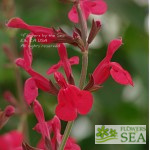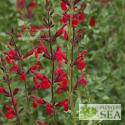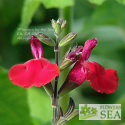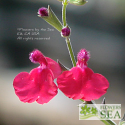(Windwalker® Desert Rose Sage) Hot pink flowers top glossy, mid-green foliage top Windwalker® Desert Rose Salvia. Due to drought resistance, Salvia x 'Desert Rose' is a great choice for dry gardens. However, this petite beauty also grows well with moderate watering.
The short height and compact, rounded form of Desert Rose make it ideal for colorful garden borders. Regularly removing spent flower spikes allows it to bloom for months. This tough perennial grows well in full sun or partial shade and is similarly adaptable to a variety of soils.
Colorado horticulturist Kelly Grummons crossed Salvia lemmonii (Lemmon's Sage) with Salvia 'Raspberry Delight' (Raspberry Delight Sage) to create Desert Rose. It can be difficult to track the parentage of plants in the Salvia genus - also called "true sages" and including more than 1,000 species - because many easily self-hybridize. However, Raspberry Delight is reportedly a hybrid of Salvia greggii 'Furman's Red' and various high altitude Mountain Sages from Arizona. This may account for Desert Rose's foliage, which is similar to that of Salvia greggii (Autumn Sage).
Both Autumn Sage and Mountain Sage are native to the U.S. and Mexico. Some botanists consider Salvia lemmonii (Lemmon's Sage) to be a variant of Mountain Sage. Plant explorers John Gill Lemmon (1832-1908) and Sara Allen Lemmon (1836-1923) discovered it while on their honeymoon in Southeastern Arizona around 1881. More information about their discovery is available in our blog post Getting Started: Salvias for the Southwest.
Don't confuse this Windwalker® selection with Windwalker® Royal Red Salvia, for which Grummons crossed Salvia darcyi and Salvia microphylla. Both are introductions from Colorado's PlantSelect® program that focuses on xeric gardening. Plant Select's botanical name for the unpatented Windwalker® Desert Rose Salvia is Salvia lemmonii 'PWIN04S'. The botanical name we use for this plant reflects its complex hybrid nature.





